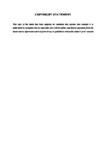Buckling behaviour of cold-formed steel beams with web perforations
| dc.contributor.supervisor | Kim, Boksun | |
| dc.contributor.author | Yu, Nanting | |
| dc.contributor.other | School of Engineering, Computing and Mathematics | en_US |
| dc.date.accessioned | 2022-01-19T11:18:01Z | |
| dc.date.issued | 2022 | |
| dc.identifier | 10579223 | en_US |
| dc.identifier.uri | http://hdl.handle.net/10026.1/18585 | |
| dc.description | Chapter 3 of this thesis have been published in Thin-Walled Structures. | en_US |
| dc.description.abstract |
Cold-formed steel (CFS) members are widely used in the constructional industry, because CFS has high strength-to-weight ratio and can be easily fabricated into different shapes. In order to accommodate services like electric wires and pipelines, perforations are commonly punched into the web of CFS beams. However, the appearance of web openings may reduce the properties of the cross section and hence change the stress distribution along the longitude axis. As a result, the perforated cold-formed steel (PCFS) beam is more susceptible to lateral-torsional buckling. For specific cross sections controlled by distortional buckling, the restraint of web on the flange weakens due to the web perforations and hence the PCFS beam may fail more easily than the CFS beam. Among all the current specifications, the design equations for determining the critical stress of PCFS beams are non-existent. In addition, the design guideline of CFS mainly concentrates on the loading conditions that the members subject to pure bending or compression, while the uniformly distributed load is more common in beams. It is known that singly PCFS beams have low lateral stiffness and torsional rigidity about the weak axis which lead to them suffering from distortional or lateral-torsional buckling. To use PCFS sections with larger scale in structures, back-to-back built-up CFS beams with web perforations are commonly employed. They are connected by two individual PCFS studs using self-drilling screws. However, the application of built-up CFS beams with web perforations in practice is encountering challenges due to the lack of suitable design method. The researchers are prone to modify the design equations of hot-rolled I sections to predict the ultimate strength of built-up CFS sections, but this approach was found to be conservative. This project aims to investigate the buckling behaviour of CFS beams with web perforations. Simplified analytical models based on energy method were proposed to predict the critical stress of distortional buckling of PCFS beams subject to pure bending and uniformly distributed load, and the effect of variant moment distribution along the longitude axis was examined. Li’s model proposed in 2004 was modified for the calculation of the lateral-torsional buckling of PCFS beam subject to pure bending and uniformly distributed uplift load, and the influences of lateral and translational restraint provided by sheeting were discussed. Elastic finite element models were developed by using commercial software ANSYS to investigate the influence of hole sizes and cross-section dimensions on the buckling behaviour of PCFS beams. The results have shown a good agreement between the finite element analysis data and theoretical results. In this study, non-linear finite element models including material, geometrical and contact non-linearity were performed to explore the structural behaviour of CFS built-up beams with web perforations subject to pure bending. The numerical results were verified against the existing experimental data in the literature. Afterwards, the validated finite element models were employed for the extensive parametric study. A total of 398 numerical simulations were conducted to examine the influence of hole sizes, hole spacing, beam slenderness and screw arrangements. The current direct strength method for PCFS beams was extended for the design rule of CFS built-up beams with web perforations subject to pure bending. This thesis has contributed to improve the understanding of distortional and lateral-torsional buckling behaviour of PCFS beams subject to pure bending and uniformly distributed load, the data obtained from the numerical investigations provided a thorough grounding for further design of CFS built-up beams with web perforations. | en_US |
| dc.language.iso | en | |
| dc.publisher | University of Plymouth | |
| dc.rights | CC0 1.0 Universal | * |
| dc.rights.uri | http://creativecommons.org/publicdomain/zero/1.0/ | * |
| dc.subject | Cold-formed steel beams | en_US |
| dc.subject | Web perforations | en_US |
| dc.subject | Built-up sections | en_US |
| dc.subject | Buckling, distortional | en_US |
| dc.subject | Buckling, lateral-torsional | en_US |
| dc.subject | Finite strip method | en_US |
| dc.subject | Finite element method | en_US |
| dc.subject | Pure bending | en_US |
| dc.subject | Uniformly distributed load | en_US |
| dc.subject | Stress gradient | en_US |
| dc.subject | Energy method | en_US |
| dc.subject | Built-up section | en_US |
| dc.subject | Ultimate capacity | en_US |
| dc.subject | Non-linear analysis | en_US |
| dc.subject | Direct strength method | en_US |
| dc.subject.classification | PhD | en_US |
| dc.title | Buckling behaviour of cold-formed steel beams with web perforations | en_US |
| dc.type | Thesis | |
| plymouth.version | publishable | en_US |
| dc.identifier.doi | http://dx.doi.org/10.24382/1046 | |
| dc.identifier.doi | http://dx.doi.org/10.24382/1046 | |
| dc.rights.embargodate | 2023-01-19T11:18:01Z | |
| dc.rights.embargoperiod | 12 months | en_US |
| dc.type.qualification | Doctorate | en_US |
| rioxxterms.version | NA | |
| plymouth.orcid.id | 0000-0003-3258-3637 | en_US |
Files in this item
This item appears in the following Collection(s)
-
01 Research Theses Main Collection
Research Theses Main



